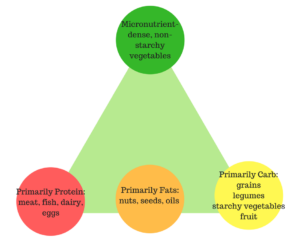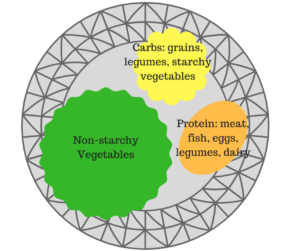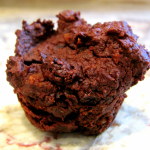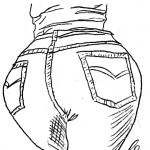A naturopathic doctor offers tips for navigating the often contradictory and confusing world of modern human nutrition.
 As soon as we start to feel comfortable with our grasp of human nutrition—which foods are healthy, which ones are unhealthy, and how to eat a balanced diet for optimal health—a new study gets published that shatters our once-felt sense of confidence.
As soon as we start to feel comfortable with our grasp of human nutrition—which foods are healthy, which ones are unhealthy, and how to eat a balanced diet for optimal health—a new study gets published that shatters our once-felt sense of confidence.
Confusingly contradictory health claims constantly appear in the news, like the American Heart Association’s vilification of coconut oil. The vegan diet-promoting documentary What the Health, currently trending on Netflix, turns convention on it head by assuaging our fears of refined sugar, instead blaming animal protein, eggs and dairy for the worldwide diabetes epidemic. Even I find myself doubting the 15 years I’ve spent studying and working in the field of human health every time paradoxical nutritional data is uncovered.
When I was in high school, I remember patting myself on the back for choosing fat-free options, hoping the leanness of my food would encourage leanness of my flesh. I gave up meat, understanding that I was making a healthier choice; I was told that meat, fat and cholesterol were all culprits of heart disease. I tried giving up eggs and dairy, trying on veganism in order to minimize my impact on the environment. I did an elimination diet while at naturopathic medical school, removing gluten. When my colleagues started reading about the Paleo Diet—grains were the enemy all along, while meat was good for us—I slowly began to embrace a “primal” diet. I started removing myself from the influence of decades’ worth of poorly conducted research and began welcoming saturated fat back into my life. Fat was fine; it was carbs that were the root of all disease. Atkins had gotten it right from the beginning. Eventually I cut out all carbs and sugar and tried a ketogenic diet, eating lots of fat, moderate amounts of meat, and some vegetables.
My journey brings me here, to my Facebook newsfeed, which has been infiltrated with articles condemning coconut oil and saturated fat for raising LDL cholesterol and contributing to cardiovascular disease. “But I thought it was healthy!” Friends, family and patients cry, tearing their hair out in confusion over the news. Some patients have watched Netflix’s What the Health, a documentary from the makers of Cowspiracy, which asserts that sugar’s link to type II diabetes may not bas as strong as previously thought.
The flip-flopping is frustrating for sure, especially for those of us who are committed to living healthy lives for as long as possible. But before we toss our tubs of coconut oil and liquid stevia drops in the garbage and start pulling out the white sugar and margarine again, we should consider how nutritional research is conducted. Let’s entertain different traditional, holistic viewpoints on food and nutrition in order to learn how to feed our bodies optimally.
The Problem with Nutritional Research
There are several problems with how we study nutrition. One of the challenges lies within science itself; scientific studies, by their very nature, attempt to isolate all of life’s complexity down to two variables in order to study them while nutrition, as it’s practised in the day to day lives of human beings, consists of an infinite number of important factors that are often not taken into account.
Most human diet studies are epidemiological. Researchers follow populations of people for years, tracking what they eat and noting how many diseases they get over time. They then synthesize the data to create story. For instance, how much fibre did the people who had heart disease eat? Did those who avoided gluten have a higher risk of diabetes?
In order to assess dietary intake, most epidemiological studies use Food Frequency Questionnaires, or FFQs. Study participants are asked how often they eat certain foods (such as chicken) per week. They are asked to check a box, from “none” to “more than 6 times a week”. As a clinician interested in how my patients’ nutrition may be affecting their health, I assess diet in a few different ways. In the initial appointment, I ask my patients to recall everything they’ve consumed in the past 24 hours to get a rough overview of how they typically eat. Then, between the first and second appointments, I have my patients track their foods in a diet diary over the course of one to two weeks. The accuracy with which my patients report their food intake from the day before depends on their memories, perceptions, and diligence in recording, among other things, and this can compare drastically with their diet diaries that are recorded in real time. Not only do the mundane memories of daily meals evade us, we are often found guilty of deceiving ourselves based on how we feel we should be eating, rather than how we actually are. I find it hard to believe that participants are filling out FFQs accurately.
Also, the stories that epidemiological studies create from the data establish correlation, not causation. With many correlations (like one of my favourites: ice cream consumption and drowning—both occur in summer) there is often no direct relationship. If assessing the connection between fat intake and diabetes, a good study will take into account all meaningful variables, such as how often the participants exercised, or whether they had existing cardiovascular disease. However, considering all the possible factors that might effect the relationship is virtually impossible. For instance, what was the status of the gut flora of the participants? What was their antioxidant or mineral status; were they magnesium deficient? Were they consuming meat that was pasture-raised or corn-fed? How high was their daily toxic exposure? Did they experience chronic stress? How well were they sleeping? What were their levels of inflammation like? And so on.
The trouble with studying nutrition and disease is that, when it comes to health, context matters; context may be all that matters. For instance, while we know that barbecued meat can produce carcinogens that potentially lead to cancer, a study found that when the meats were seasoned with rosemary the carcinogenic load of the meat was neutralized. It’s nearly impossible to form a complete picture when we insist on studying isolated factors, leaving out many important details.
Animal studies, while allowing for tighter control (we don’t ask mice to report their diets, we just feed them), are also flawed. Firstly, mice and humans are completely different species with different nutrient requirements. However, animal study designs can also be problematic. Animals are given lard and white sugar to assess the effects of a high fat, high sugar diet on their health—their diets are exaggerated for the purpose of the study. Human beings, however, eat burgers, cake, and ice cream. We don’t eat single nutrients like fat and sugar, we eat food. If a mouse gets sick on a diet of lard and table sugar is it because of the foods it was eating, something he wasn’t eating, or some other unforeseen factor? There may be a huge difference between eating a high-fat diet with no vitamins and minerals, and eating a high-fat diet that contains complete nutrition.
A third method for studying human nutrition is through randomized control trials, or RCTs. In RCTs humans are randomized into a group that receives an intervention, like a dietary plan, or a control group that is told to follow some other diet or just eat normally. These trials control as many variables as possible, but the timeframe for these studies is often too short to garner meaningful information about health outcomes, which may take years to manifest. It is also difficult to get participants to stick to meal plans. Further, it’s hard to establish consensus for each diet being studied. For example, when assessing the nutritional merits of the Paleo diet, how many servings of vegetables should participants be told to consume? How many grams of fat? What types of fat?
It’s important that we can use studies to seek answers to our questions about the relationship between nutrition and health. However, due to its many limitations, nutritional research can only take us so far. This is why one study may indicate that high sugar diets contribute to diabetes risk, while another study finds no relationship.
A New Food Guide
If we can’t trust research studies to tell us what to eat, who do we trust? Surely we can’t rely on Canada’s Food Guide, with it’s outdated recommendations that simultaneously overemphasize grains and dairy, while continuing to uphold archaic views on fat. Primarily created in the 40’s to help Canadian families ration their food during the war, the Food Guide was not necessarily created to promote the optimal health of those who follow it.
 Dr. Ray Cronise, a former NASA scientist, outlines a food pyramid in his paper to help organize food into nutrient content. I often borrow his pyramid to depict nutritional balance to my patients.
Dr. Ray Cronise, a former NASA scientist, outlines a food pyramid in his paper to help organize food into nutrient content. I often borrow his pyramid to depict nutritional balance to my patients.
Ray’s pyramid is composed of four circles, three that form the base of the pyramid, forming the three main groups of macronutrients: protein, fat, and carbohydrates, and foods that are composed primarily of each. The circle at the top represents the foods that contain a higher number of micronutrients: vitamins and minerals, which are mainly non-starchy vegetables like leafy greens.
Protein-rich foods include meat and animal products, including fish, eggs and dairy. Fat-rich foods include nuts, seeds and oils like coconut oil, avocado and olives. Carbohydrate-rich foods include starchy vegetables like potatoes, grains, legumes and fruit. Ray concedes, however, that none of these foods are composed of a single macronutrient; animal products often contain a significant amount of fat; nuts and seeds also contain protein and carbohydrates; and legumes and grains contain some protein as well.
Ray points out that most diets, particularly the Standard American Diet, is bottom-heavy. North Americans generally over-consume macronutrient-rich foods that are higher in fats, carbs, proteins, and calories in general, and under-consume micronutrient-rich foods like fruits and vegetables. Because of this, North Americans consistently fail to meet the levels of vitamins, minerals and antioxidants essential for optimal bodily function.
It seems that even “healthy” diets tend to focus on the bottom of the pyramid, restricting certain groups of foods while making up the balance by over-emphasizing others. Paleo and low-carb dieters often fixate on the right side of the pyramid, including animal products, nuts and seeds, but avoiding grains and legumes, while vegan and vegetarian diets concentrate on the left side of the pyramid, eschewing all animal products and getting protein from grains, legumes and nuts instead.
One thing all healthy diets seem to emphasize, however, is fruit and vegetable consumption. When studying the merits of a vegan or paleo diet, it is the non-starchy, micronutrient-rich vegetables that may confer most of the health benefits, regardless of the carb, fat and protein content. Therefore, Ray recommends focusing on the top of his food pyramid, eating as many vegetables as possible, while eating a balance of foods from the base.
 Since we rarely eat pyramids, I often depict this balance for my patients using a plate. I divide the plate into four quarters. One half of the plate is dedicated to colourful vegetables, with at least a full quarter dedicated to greens. The other two quarters of the plate are divided into starches: grains, legumes, tuberous vegetables, and proteins: meat, dairy, eggs, fish, or legumes. Oils and fats can be used to cook with or added to the meal in the form of avocados, nuts and seeds.
Since we rarely eat pyramids, I often depict this balance for my patients using a plate. I divide the plate into four quarters. One half of the plate is dedicated to colourful vegetables, with at least a full quarter dedicated to greens. The other two quarters of the plate are divided into starches: grains, legumes, tuberous vegetables, and proteins: meat, dairy, eggs, fish, or legumes. Oils and fats can be used to cook with or added to the meal in the form of avocados, nuts and seeds.
Listening to the Body as Guide
So, while Ray’s advice to eat as many green and colourful vegetable as we can while eating a balance of the foods at the bottom of the pyramid is sound, how can we establish what the right balance is for us? Many of us will have vastly different requirements for the macronutrients: carbs, fat and protein. My body has an energy demand that is different from that of my 6′ friend who lifts weights daily, or my 90-year old hypertensive, mainly sedentary Italian grandmother. As a naturopathic doctor, who believes in an individualized approach to health, I tend to reject top-down dietary recommendations that ignore the variabilities among people.
A friend of mine, having damaged his health through a string of restrictive dieting, argues that all food—even refined sugar and saturated fat—has a place in a healthy diet. He believes our bodies are designed to crave fat, protein and carbohydrates in ratios that promote optimal health. He writes in his book that we can eat whatever we want as long as we eat intuitively and avoid foods laden with “fake” flavours and processed oils, like corn oil, that confuse our internal cues and hunger signals. He also argues, like the filmmakers in the Netflix documentary, What the Health, that there is no evidence that refined sugar causes diabetes, and that diets based on avoidance of certain foods are detrimental for health.
While I’m not convinced that refined sugar deserves to be completely cleared of all charges, I agree that mindful and intuitive eating may be the key to maintaining balance. Healing with Whole Foods by Paul Pitchford places awareness and physical activity at the base of its Integrative Food Pyramid. The idea is that we need to first establish the foundations of movement and mindfulness before we begin to talk about food intake. As my friend says, perhaps the key is tuning in to our own internal physiological and emotional cues through mindfulness, paying attention to hunger and cravings, rather than measuring calories, carbs, protein, or fat grams.
Following our internal cues may be difficult, as the book The Dorito Affect outlines. The author points out how certain foods are engineered to override our hunger and satiation signals and monopolize our cravings, leading us to overeat. Therefore, if we’re going to follow our body’s signalling, mindfulness is a requirement, but so is following the advice of Michael Pollen, author of The Omnivore’s Dilemma, who famously tells us to “Eat food. Not too much. Mostly Plants.”
Pollen urges us to stick to foods that resemble something we might encounter in nature: eat foods our grandmothers would recognize; purchase foods that come from a plant, not foods that are made in one; and to stick to whole foods or packaged foods with five listed ingredients or less. Pollen also encourages us to cook and prepare as much of our own foods as possible. Do you have a craving for potato chips, ice cream, or dark chocolate? Feel free to indulge, as long as you make it yourself using the raw, natural ingredients. The theory is that, when the body is given clean, whole food, it regulates its hunger and satiety signals to communicate to you exactly what it needs.
Heal the Individual
When it comes to whole foods, I believe that there are no “good” or “bad” foods, generally speaking. Observational studies that examine how traditional societies ate suggest to us that saturated fat, animal protein, dietary cholesterol, and carbohydrates all have a place in a balanced diet. However, when it comes to diet, especially therapeutic diets, it’s my job to consider the individual and their health context: there are no good or bad foods, but some foods are better or worse for certain people, and some may even be better or worse for certain people at certain points along their health journeys.
When I am helping my patients calm inflammation, heal their digestive systems, clear their skin, or manage autoimmune disease, I often recommend identifying food sensitivities and eliminating those foods from the diet. Oftentimes these foods need to removed only temporarily, but sometimes foods may need to be removed indefinitely. Patients with insulin resistance, such as in the cases of obesity, PCOS, diabetes or metabolic syndrome, often do well on a low-carbohydrate diet to restore insulin sensitivity. Again, these anti-inflammatory, reduced-carbohydrate diets may only be required until hormonal balance is restored. Older adults concerned with promoting longevity, or patients undergoing cancer treatment, may do better restricting protein to lower their levels of growth factors, while athletes and stressed out adults may require higher amounts of protein to promote muscle building, or to synthesize mood-regulating neuro-chemicals. A woman who is stressed, depressed, exhausted and iron deficient may feel much better increasing her dietary intake of red meat to help regulate her nervous system. Another woman, with a family history of colon cancer, may do better avoiding it.
Endless factors need to be taken into account when we consider which dietary style is right for us. Our health goals, health status, nutrient status, digestive system health, immune system health, liver functioning, insulin sensitivity and hormone balance, levels of stress, toxic load and inflammation are just some of the things that I consider when making lifestyle recommendations for my patients. Lifestyle preferences, tradition, culture, religious backgrounds, cooking abilities, time constraints, and other factors, will also all play a role in our food choices and eating habits.
Our emotional connection to food and our ethics also matter. While veganism is certainly not a diet I recommend, if consuming animal products is out of line with one’s morals, then following a vegan diet may be the healthiest way for them to live in accordance his or her beliefs. Similarly, someone with a history of disordered eating may need to lift all food limitations, even junk food, in order to heal his or her relationship with food and hunger.
Investigations into the eating patterns of traditional societies tell us that human beings thrive on a variety of different diets. Optimizing diet for the individual goes beyond following the latest research or government and industry-funded health recommendations. It involves eating a variety of natural, whole foods, learning to pay attention to the body’s hunger signals, and even working with a health professional who uses diet to help promote health and manage disease on an individual level.






